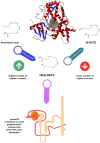Camel Proteins and Enzymes: A Growing Resource for Functional Evolution and Environmental Adaptation
- PMID: 35903143
- PMCID: PMC9315206
- DOI: 10.3389/fvets.2022.911511
Camel Proteins and Enzymes: A Growing Resource for Functional Evolution and Environmental Adaptation
Erratum in
-
Corrigendum: Camel proteins and enzymes: a growing resource for functional evolution and environmental adaptation.Front Vet Sci. 2024 Nov 7;11:1492459. doi: 10.3389/fvets.2024.1492459. eCollection 2024. Front Vet Sci. 2024. PMID: 39575437 Free PMC article.
Abstract
In less agroecological parts of the Asian, Arabian, and African deserts, Camelus dromedarius play an important role in human survival. For many years, camels have been employed as a source of food, a tool of transportation, and a means of defense. They are becoming increasingly important as viable livestock animals in many desert climates. With the help of camel genetics, genomics and proteomics known so far, this review article will summarize camel enzymes and proteins, which allow them to thrive under varied harsh environmental situations. An in-depth study of the dromedary genome revealed the existence of protein-coding and fast-developing genes that govern a variety of metabolic responses including lipid and protein metabolism, glucoamylase, flavin-containing monooxygenase and guanidinoacetate methyltransferase are other metabolic enzymes found in the small intestine, liver, pancreas, and spleen. In addition, we will discuss the handling of common medications by camel liver cytochrome p 450, which are different from human enzymes. Moreover, camels developed several paths to get optimum levels of trace elements like copper, zinc, selenium, etc., which have key importance in their body for normal regulation of metabolic events. Insulin tolerance, carbohydrate and energy metabolism, xenobiotics metabolizing enzymes, vimentin functions, behavior during the rutting season, resistance to starvation and changes in blood composition and resistance to water loss were among the attractive aspects of camel enzymes and proteins peculiarities in the camels. Resolving the enigma of the method of adaptation and the molecular processes linked with camel life is still a developing repository full of mysteries that need additional exploration.
Keywords: adaptation; camel; enzymes; metabolism; proteins.
Copyright © 2022 Kandeel, Al-Taher, Venugopala, Marzok, Morsy and Nagaraja.
Conflict of interest statement
The authors declare that the research was conducted in the absence of any commercial or financial relationships that could be construed as a potential conflict of interest.
Figures




References
-
- Reed CA. The origin of the domestic animals of Africa. H. Epstein. Revised in collaboration with IL Mason. Africana, New York: American Association for the Advancement of Science; (1972).
-
- Trinks A, Burger PA, Beneke N, Burger J. Simulations of populations ancestry of the two-humped camel (Camelus bactrianus). In: Camels in Asia and North Africa. Interdisciplinary Perspectives on their Significance in Past and Present. Austrian Academy of Sciences Press (2012). pp.79–86.
Publication types
LinkOut - more resources
Full Text Sources
Miscellaneous

